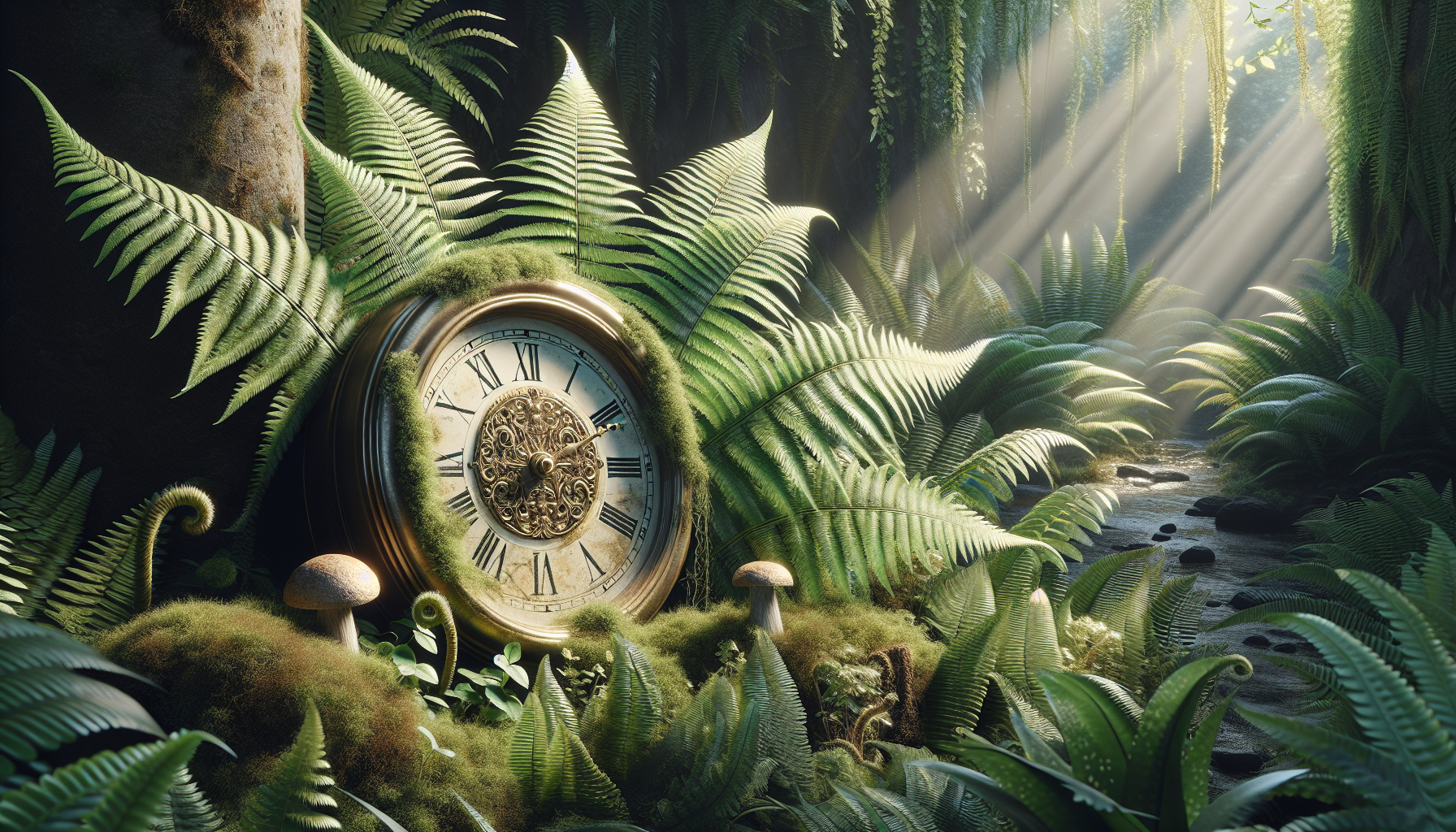In a world where the pace of life seems to accelerate with each passing moment, there exists a quiet, ancient force that has remained unchanged for millions of years. Ferns, with their lush green fronds and intricate patterns, are nature’s silent timekeepers, preserving the secrets of the earth’s past while offering timeless elegance to modern landscapes. These remarkable plants have thrived for over 360 million years, witnessing the rise and fall of dinosaurs, the shifting of continents, and the evolution of countless species. As we embark on a journey to explore the fascinating world of ferns, we uncover not only their aesthetic appeal but also their ecological significance and the profound lessons they teach us about resilience and adaptation. 🌿
Ferns are more than just decorative elements in our gardens or the forest understory; they are living fossils, offering a glimpse into the prehistoric past. Their ability to survive and adapt through drastic climatic changes makes them powerful symbols of endurance and sustainability. In this article, we delve into the unique characteristics that have allowed ferns to endure for eons, from their reproduction strategies that don’t rely on flowers or seeds, to their symbiotic relationships with fungi that aid in nutrient absorption. We will explore how these primitive plants contribute to biodiversity and their role in ecosystems, providing habitat and food for a myriad of organisms. By understanding the science behind ferns, we gain insights into the resilience strategies that can inspire sustainable practices in our own lives and communities.
As we unravel the mysteries of ferns, we also discover their surprising versatility in modern applications. Beyond their ecological importance, ferns have made their way into art, architecture, and even medicine, proving that their relevance extends far beyond their prehistoric roots. This article will highlight the innovative ways in which designers and architects are incorporating ferns into urban environments, creating green spaces that enhance well-being and mitigate the effects of climate change. Additionally, we’ll look at the cultural significance of ferns in various societies, exploring the myths and traditions that celebrate their enduring beauty and symbolic power. Join us as we embrace the timeless elegance of ferns, and learn how these ancient plants can guide us towards a more harmonious relationship with the natural world. 🍃
The Ancient Roots of Ferns: A Historical Perspective
Ferns, with their delicate fronds and intricate patterns, have captured the human imagination for centuries. These plants are not only beautiful but have a rich historical lineage that dates back millions of years. As one of the oldest groups of plants, ferns have survived through various geological eras, providing a living testament to the resilience and adaptability of nature. From the lush forests of the Paleozoic era to modern urban landscapes, ferns have thrived in diverse environments, showcasing their versatility and endurance.
The history of ferns can be traced back to the Devonian period, around 360 million years ago, when they were among the dominant plant forms on Earth. During this time, the planet was experiencing significant climatic changes, which saw the rise of more complex plant life. Ferns, with their simple yet effective reproductive strategies, were well-suited to these changing conditions. Their ability to reproduce via spores allowed them to colonize new areas rapidly, paving the way for their proliferation across different continents.
Ecological Significance and Evolutionary Adaptations
Ferns are unique in their ecological roles and evolutionary adaptations. Unlike flowering plants, ferns do not produce seeds. Instead, they reproduce through spores, a strategy that has both advantages and limitations. This method of reproduction is less energy-intensive and allows ferns to produce numerous offspring in a short time, increasing their chances of survival in competitive environments.
One of the key adaptations of ferns is their ability to thrive in low-light conditions, often found on the forest floor. Their fronds are optimized for capturing diffuse sunlight, allowing them to photosynthesize efficiently even under dense canopies. This adaptation has enabled ferns to inhabit a variety of niches, from moist tropical undergrowth to arid desert crevices.
Another fascinating adaptation is the diversity of fern forms. From the towering tree ferns of tropical regions to the diminutive rock ferns clinging to cliff faces, these plants exhibit a wide range of morphologies. This diversity is a testament to their evolutionary success and ability to exploit different ecological opportunities.
The Role of Ferns in Modern Ecosystems
In contemporary ecosystems, ferns continue to play vital roles. They contribute to soil formation and stabilization, particularly in areas prone to erosion. Their extensive root systems help bind soil particles, reducing the risk of landslides and maintaining soil health. Additionally, ferns are essential components of many food webs, providing habitat and nourishment for various organisms.
Their ability to thrive in diverse environments makes them valuable indicators of ecosystem health. For instance, the presence of certain fern species can signal a well-functioning, biodiverse ecosystem, while their absence may indicate ecological degradation. As climate change impacts natural habitats, understanding the ecological roles of ferns becomes increasingly important for conservation efforts.
Moreover, ferns have been utilized in phytoremediation, a process where plants are used to remove or neutralize pollutants from the environment. Their natural ability to absorb heavy metals and other contaminants makes them useful in rehabilitating polluted sites. This application underscores the ecological and environmental significance of ferns in modern conservation practices.
Ferns and Biodiversity Conservation
Biodiversity conservation is a pressing global issue, and ferns play a significant role in maintaining ecosystem diversity. Their presence in various habitats supports a wide range of other species, from insects to mammals. By conserving ferns, we also protect the myriad of life forms that depend on them.
Efforts to conserve fern species are crucial, especially in regions where they face threats from habitat loss and climate change. Conservation strategies often involve protecting natural habitats, restoring degraded areas, and promoting sustainable land-use practices that accommodate fern populations. These initiatives help safeguard not only ferns but also the broader ecological networks they support.
As part of conservation efforts, botanical gardens and research institutions around the world cultivate and study diverse fern species. These living collections serve as important genetic reservoirs and provide valuable insights into fern biology, aiding in their preservation and propagation. By understanding the ecological roles and requirements of ferns, we can better protect these ancient plants and the ecosystems they inhabit.
Ferns in Cultural and Medicinal Contexts
Beyond their ecological significance, ferns hold a prominent place in cultural and medicinal contexts. Throughout history, they have been revered for their beauty and symbolism. In many cultures, ferns are associated with magic and mystery, often featured in folklore and mythology. Their delicate and intricate fronds have inspired art, poetry, and design, capturing the imagination of artists and creators worldwide.
Medicinally, ferns have been used in traditional healing practices for centuries. Various species are known for their therapeutic properties, including anti-inflammatory, diuretic, and antimicrobial effects. While scientific research on the medicinal benefits of ferns is ongoing, their potential in natural medicine continues to intrigue researchers and herbalists alike.
Incorporating ferns into gardens and landscapes is another way they enrich human life. Their lush greenery and distinctive forms add aesthetic value to both private and public spaces. Moreover, as low-maintenance plants, ferns are ideal for gardeners seeking sustainable and environmentally friendly landscaping options.
Integrating Ferns into Modern Design
The versatility of ferns makes them excellent candidates for modern interior and landscape design. Their ability to thrive in low-light conditions allows them to flourish indoors, enhancing air quality and providing a touch of nature in urban settings. Interior designers often use ferns to create serene and inviting spaces, leveraging their calming presence to improve mental well-being and reduce stress.
In landscape design, ferns are utilized to create naturalistic gardens that mimic wild habitats. Their textural diversity and compatibility with other shade-loving plants make them valuable components of garden compositions. By incorporating ferns into garden designs, landscapers can create vibrant, dynamic spaces that support biodiversity and promote environmental sustainability.
Technological Applications and Future Research
As scientific research continues to explore the potential of ferns, new technological applications are emerging. One promising area is the use of ferns in bioengineering and biomimicry. Scientists are studying the structural properties of fern fronds to develop new materials and technologies, such as lightweight, flexible structures for engineering and construction.
Additionally, the genetic study of ferns is yielding insights into plant evolution and adaptation. Advances in genomics and molecular biology are uncovering the genetic basis of fern resilience, providing valuable information for crop improvement and climate change mitigation efforts. This research has the potential to inform agricultural practices, helping to develop crops that are more resilient to environmental stressors.
The future of fern research holds exciting possibilities, as scientists continue to uncover the secrets of these ancient plants. From ecological restoration to biotechnology, ferns offer a wealth of opportunities for innovation and discovery. By harnessing their unique properties, we can address pressing environmental challenges and foster a deeper appreciation for the natural world.
Call to Action: Explore the World of Ferns
If you’re intrigued by the fascinating world of ferns, consider exploring them further through local botanical gardens, nature reserves, or online resources. Engage with community conservation projects that aim to protect and restore fern habitats. By learning more about these remarkable plants, you can contribute to their preservation and help raise awareness of their ecological importance.
For those interested in incorporating ferns into their surroundings, experiment with different species and designs to enhance your living space. Whether you choose to cultivate ferns indoors or integrate them into outdoor landscapes, these plants offer endless possibilities for creativity and connection with nature.
To delve deeper into the subject, watch this insightful video on the role of ferns in modern ecosystems: “The Role of Ferns in Modern Ecosystems” by Fern Channel. Discover how these ancient plants continue to shape our world and inspire future innovations.

Conclusion
In reflecting upon the intricate tapestry of knowledge woven throughout this article, we have traversed the verdant paths of ferns, those enigmatic and elegant plants that serve as nature’s silent timekeepers. Our journey has illuminated the myriad ways in which ferns, with their ancient lineage and enduring presence, contribute profoundly to both ecological balance and cultural significance.
Initially, we explored the fascinating biology of ferns, delving into their unique reproductive cycle and resilience. Ferns are non-flowering vascular plants that reproduce through spores, a process that underscores their adaptability and survival through millennia. Their intricate fronds, emerging in a rhythmic unfurling known as “circinate vernation,” exemplify nature’s delicate artistry and the timeless elegance inherent in simplicity.
Furthermore, our discussion highlighted the ecological roles ferns play within their habitats. Acting as essential components of forest undergrowth and providing a refuge for numerous species, they also contribute to soil stabilization and moisture retention. By maintaining biodiversity and supporting complex ecosystems, ferns underscore the interconnectedness of life, reminding us of our own place within the natural world.
From an anthropological perspective, ferns have been venerated across cultures and epochs. Their symbolism ranges from prosperity and protection to dreams and magic, finding expressions in art, literature, and traditions. This cultural resonance speaks to the deep, almost spiritual connection humans have forged with these plants, recognizing their role as both a physical and metaphorical bridge to the past.
Our exploration would be incomplete without acknowledging the contemporary applications of ferns in various fields. In medicine and environmental science, ferns offer promising avenues for research and innovation. Their phytoremediation capabilities, for instance, present sustainable solutions for pollution mitigation. Moreover, ongoing studies into their chemical compositions reveal potential medicinal properties, particularly in treating ailments and diseases.
The narrative of ferns, with their remarkable endurance and versatility, is a testament to the resilience of nature. In an era where environmental concerns loom large, the lessons we glean from these plants become even more pertinent. They remind us of the importance of conservation and the need to preserve the natural world for future generations.
As we conclude this exploration of ferns, let us recognize the profound elegance they embody—an elegance that is timeless, silent, yet ever-present. We are called to appreciate the subtle beauty of the natural world and to reflect on how its wisdom can guide us toward more sustainable living.
I encourage you, dear reader, to carry forward the insights gained here. Whether through mindful observation of ferns in their natural habitats or through engagement in conservation efforts, each action contributes to a larger narrative of ecological stewardship. Share this knowledge with others, fostering a community that values and protects the intricate balance of our planet.
Feel free to leave your thoughts or experiences in the comments below—your voice adds to the richness of this dialogue. Share this article with friends and family, sparking conversations about the wonders of nature. Together, we can harness the power of ferns and other natural wonders to inspire change and cultivate a future where both humanity and nature thrive in harmony.
🌿 To further explore the scientific and cultural significance of ferns, consider visiting resources such as the American Fern Society [link], the Natural History Museum [link], and relevant academic publications. These sources offer deeper insights and continually updated research findings. Embrace the journey of discovery, and let the timeless elegance of ferns guide your path. 🌍
Gabriel is a visual storyteller and symbolic naturalist whose creations explore the veiled ecologies and ancestral ties between humans and the living world, as echoed through myth and memory. With a sensitivity attuned to the sacred, Gabriel unveils the ancient choreography of plant, animal, and spirit — a realm where forests spoke in signs, rivers kept secrets, and every flower bore a forgotten name.
His path winds through the esoteric — tracing the rituals of forest sages, the herbal codes of ancestral healers, and the silent agreements that once guided human life in deep reciprocity with nature. From moss-covered shrines to twilight groves, Gabriel’s work reveals relationships once vital, now buried beneath layers of modern detachment.
With a foundation in visual design and the aesthetics of ancestral wisdom, Gabriel weaves storytelling into sacred ecology. His work doesn’t just depict — it channels. Drawing from myth, mysticism, and lost herbal traditions, he crafts images and narratives that pulse with the old knowing: that nature is not scenery, but kin and teacher.
Through collections of symbolic visuals, myth-rooted studies, and intuitive reflections, Gabriel invites others to rekindle forgotten senses — to listen not only with ears, but with intuition, memory, and reverence.
His work is a tribute to:
-
The mythic language of trees, stones, and roots
-
Forgotten pacts between healers and the wild
-
The sacred intelligence in nature’s unseen patterns
Whether you walk with the lore of plants, dream with the rhythms of the earth, or simply feel the call of something older in the wind through the leaves, Gabriel welcomes you into a space where symbolism, spirit, and wild nature entwine — one myth, one leaf, one vision at a time.





